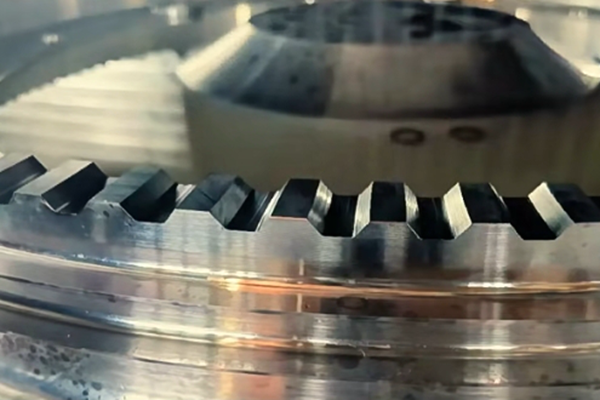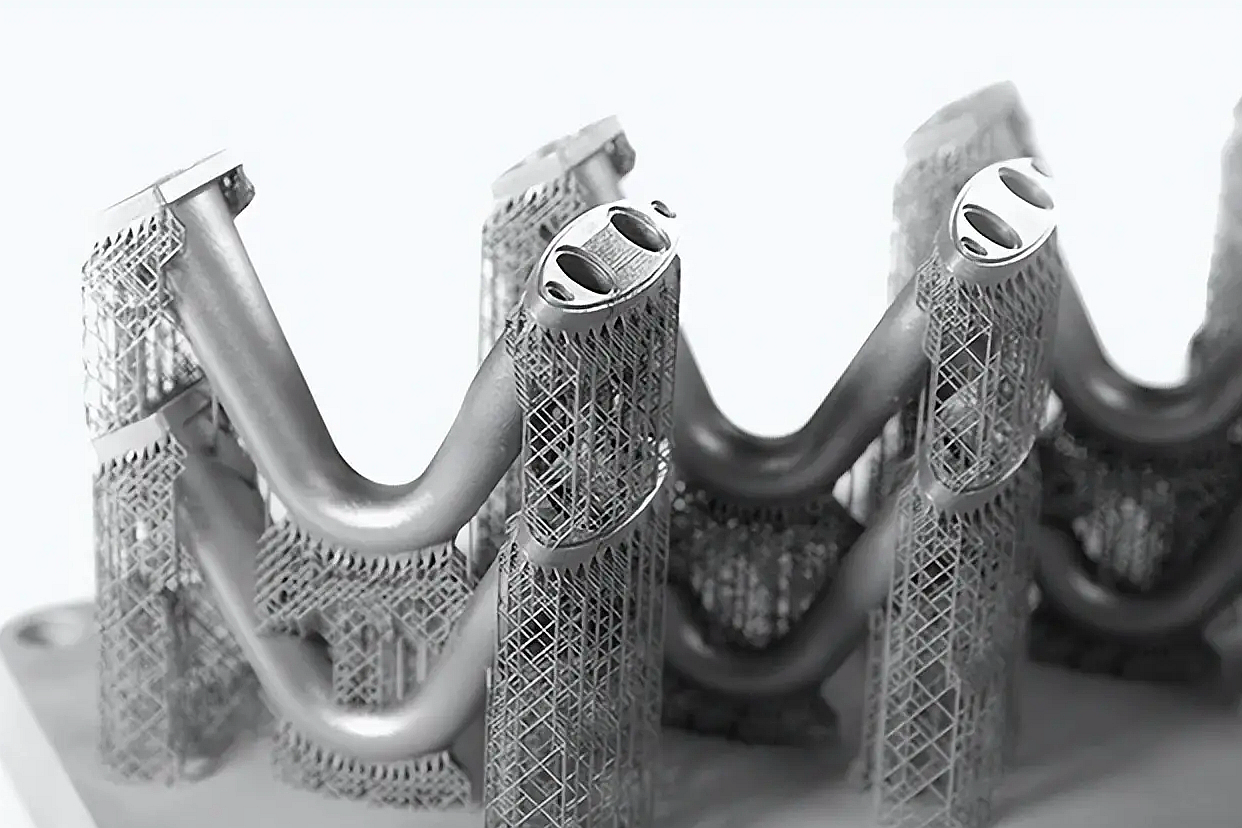Advanced Powder Superalloy Inertial Friction Welding Service Company
Inertial Friction Welding (IFW) is a solid-state welding process that has garnered significant attention in manufacturing high-performance superalloy parts. IFW is particularly valuable for creating solid and durable bonds between components of advanced superalloys designed to withstand the extreme demands of high-temperature and high-stress environments. The process involves using rotational inertia to generate heat and achieve a solid bond without the need for filler materials, making it ideal for critical applications in industries like aerospace and energy.

This blog will explore how IFW is applied in NewayAero's production processes for superalloy parts, its benefits to different superalloys, the post-processing techniques used, testing protocols, and its key applications across various industries.
Superalloy Parts Requiring Inertial Friction Welding
NewayAero’s expertise spans a broad spectrum of superalloy parts produced through different manufacturing processes such as Vacuum Investment Casting, Single Crystal Casting, Equiaxed Crystal Casting, Directional Casting, Powder Metallurgy, Forging, CNC Machining, and 3D Printing. Each of these processes is selected based on the specific application, material properties, and the desired performance of the end product.
Inertial Friction Welding (IFW) is used predominantly for joining components that require high-strength bonds while maintaining their material integrity. For example, components made from Single Crystal Superalloys, commonly used in turbine blades and discs, benefit from IFW because it ensures that the welded parts retain their crystal structure, which is crucial for high-temperature performance. Similarly, Powder Metallurgy superalloys, which are often used in turbine discs, can be welded effectively through IFW, helping to maintain material uniformity and resistance to thermal and mechanical stresses.
Directional Castings and Equiaxed Crystal Castings, commonly used for aerospace and power generation applications, are also ideal candidates for IFW. IFW offers the advantage of joining complex, geometrically challenging parts while preserving the material properties necessary for the demanding environments these parts operate in. Finally, Forged Superalloy Parts and CNC Machined Components can be welded using IFW to produce intricate, strong joints with minimal distortion.
Benefits of Inertial Friction Welding to Different Superalloys
Inertial Friction Welding (IFW) offers a variety of benefits depending on the superalloy being processed. The primary advantages include minimal heat-affected zones, preservation of material properties, and reduced risk of distortion compared to conventional welding methods.
Inconel Alloys
Inconel alloys, such as Inconel 718, Inconel 625, and Inconel X-750, are high-performance materials used extensively in aerospace and power generation due to their excellent resistance to oxidation and high-temperature creep. When these alloys are welded using IFW, they retain their high strength, fatigue resistance, and corrosion resistance, which is critical for turbine components exposed to extreme environments. The solid-state nature of IFW reduces the risk of hot cracking, which is a common challenge in conventional welding techniques when working with Inconel alloys.
CMSX and Rene Alloys
CMSX alloys, such as CMSX-4 and CMSX-10, and Rene alloys, like Rene 104 and Rene 41, which are single-crystal superalloys used in critical turbine blades and gas turbine components, also benefit significantly from IFW. These alloys require careful microstructure control to maintain performance at high temperatures. IFW ensures that the weld does not compromise the single-crystal structure, preserving the mechanical properties that are essential for longevity in high-temperature applications.
Monel, Hastelloy, and Stellite Alloys
Monel alloys, Hastelloy alloys, and Stellite alloys are primarily used for their exceptional corrosion resistance, particularly in harsh environments like chemical processing and marine applications. IFW provides a robust and reliable bonding technique without negatively affecting the corrosion-resistant properties of these superalloys. This is particularly important when these materials are used in critical components such as pumps, valves, and heat exchangers, where strength and resistance to wear and corrosion are paramount.
Nimonic Alloys
Nimonic alloys, such as Nimonic 75 and Nimonic 90, commonly used in high-temperature engine components, are ideal candidates for IFW as they preserve their high strength and thermal stability. IFW minimizes the risk of material degradation, ensuring that the welded parts can withstand the extreme conditions within gas turbines or combustion chambers.
Comparison of Post-processes After IFW
After Inertial Friction Welding (IFW), several post-processing techniques are required to enhance the material properties and ensure the welded superalloy components meet the required performance standards. These processes vary depending on the type of superalloy and the specific application of the part.
Heat treatment is one of the most common post-weld processes used to relieve stresses introduced during the welding process and restore the superalloy's mechanical properties. Heat treatment is essential for high-strength alloys like Inconel 718, as it optimizes the material’s strength, hardness, and creep resistance.
Hot Isostatic Pressing (HIP) is another critical post-process to eliminate any remaining porosity after the IFW process. HIP uses high pressure and temperature to densify the material, improving the uniformity and mechanical properties of the weld. This is particularly useful for materials like Powder Metallurgy alloys, which may have small pockets of porosity that could weaken the bond.
CNC machining is often required after welding to ensure the welded superalloy part meets precise dimensional specifications. CNC machining allows excess material removal, achieving tight tolerances and smooth finishes, which are critical for aerospace and automotive components that demand high precision.
Superalloy Welding is another post-process sometimes required after IFW for additional reinforcement or for joining different components together. This technique might be combined with IFW to improve overall joint strength and ensure that all parts are adequately welded, especially when working with complex geometries.
Finally, Thermal Barrier Coating (TBC) is frequently applied after IFW to enhance the high-temperature resistance of the welded components. TBCs protect components from thermal degradation, particularly in applications where the parts are exposed to extreme heat, such as in gas turbines and engine components.
Testing of IFW-Bonded Superalloy Components
Once the Inertial Friction Welding (IFW) process and any necessary post-processing have been completed, the components must undergo rigorous testing to ensure their performance meets industry standards. Several testing methods are employed to validate the welded superalloy components' mechanical properties, integrity, and functionality.
Tensile Testing is one of the most critical tests used to measure the strength of the welded superalloy parts. It determines the material’s ability to withstand tension without failing, providing insight into the overall strength of the weld and the parent material.
Fatigue Testing is another crucial test, particularly for components that will experience cyclic loading, such as turbine blades or engine components. This test ensures that the welded parts can endure repeated stresses without cracking or failing.
X-ray and Ultrasonic Inspection are essential non-destructive testing (NDT) methods to detect internal defects such as voids, cracks, or inclusions that could weaken the weld. These methods are essential for critical components where failure could have catastrophic consequences, such as in aerospace and power generation. Ultrasonic testing is beneficial for detecting flaws that may not be visible on the surface, ensuring the component's structural integrity.
Microstructure Analysis is used to examine the grain structure and the integrity of the weld interface. This analysis provides valuable information about the quality of the bond. It helps identify any potential welding process issues, such as grain boundary separation or undesirable phases forming in the weld zone. Techniques like EBSD analysis can offer deeper insights into the microstructural features of the weld.
Hardness Testing measures the hardness of the weld and the surrounding material. Hardness is a key indicator of the material’s ability to resist wear and deformation, especially in components subjected to high-temperature, high-stress conditions. The results help ensure that the IFW-bonded components can perform effectively under demanding operational environments.
Industry and Application of IFW for Superalloy Parts
Inertial Friction Welding (IFW) plays a vital role in producing high-performance superalloy parts across various industries. The ability to weld complex geometries without compromising the integrity of the material makes IFW an essential technique in industries where reliability and performance are paramount.
Aerospace and Aviation
In the Aerospace and Aviation industries, IFW manufactures critical components such as turbine blades, discs, and other engine parts. These components are exposed to extreme temperatures and mechanical stresses, making the reliability of the welds crucial for ensuring safety and performance.
Power Generation
The Power Generation industry benefits significantly from IFW, particularly in the production of gas and steam turbines. Superalloy components used in these turbines must withstand high temperatures, corrosive environments, and high-pressure conditions, making IFW an ideal welding method.
Oil and Gas
In the Oil and Gas industry, IFW creates solid and durable parts for drilling rigs, pumps, compressors, and other equipment that must perform reliably in harsh, high-pressure, and high-temperature conditions. The ability to weld superalloy parts with minimal distortion and excellent strength is critical for these applications.
Marine Industry
The marine industry also relies on IFW to manufacture components such as turbine blades and propulsion systems. The high corrosion resistance required in this industry makes superalloy materials an ideal choice, and IFW ensures that these materials maintain their strength and performance.
Automotive Industry
In the automotive sector, IFW is used to manufacture engine parts, transmissions, and exhaust components, and high-performance materials are necessary to improve fuel efficiency and durability. IFW allows for the creation of lightweight, strong parts that meet the demands of modern automotive engines.
Energy and Renewables
Energy and renewables, including wind turbine blades, rely on IFW to produce parts that must perform under extreme conditions. Superalloys used in these applications are designed to resist wear and corrosion while maintaining their mechanical integrity.
Chemical Processing and Pharmaceutical
The chemical processing and pharmaceutical and food industries use IFW to manufacture reactors, heat exchangers, and other high-stress components, where corrosion resistance and structural integrity are critical.
FAQs
What is Inertial Friction Welding (IFW), and how does it work in superalloy manufacturing?
What types of superalloys benefit most from Inertial Friction Welding?
How does Inertial Friction Welding compare to other welding techniques like MIG and TIG welding?
What are the key post-processing steps after IFW, and why are they important for superalloy parts?
What are the most common testing methods used to evaluate the quality of IFW-welded superalloy components?



